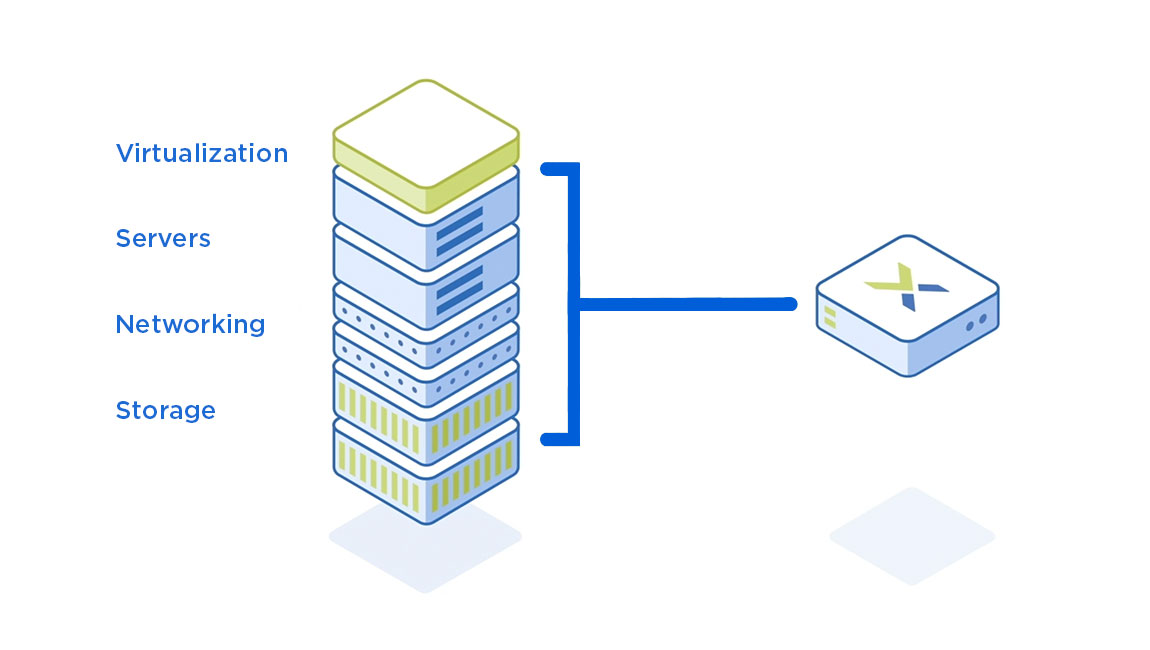Are you tired of juggling multiple vendors, managing complex IT infrastructure, and struggling with escalating costs? You’re not alone. Many organizations are facing these very challenges as they grapple with the ever-increasing demands of modern workloads.
Hyperconverged infrastructure (HCI) offers a refreshing alternative, promising to simplify IT by converging compute, storage, networking, and virtualization resources into a single, unified system. Essentially, it’s like having a data center in a box! This approach not only streamlines management but also boosts efficiency and scalability.
In this article, we’ll delve into the world of hyperconverged solutions, exploring their core components, key benefits, common use cases, and how they can help you transform your IT landscape and empower your business for future growth.
Prepare to discover how HCI can revolutionize your infrastructure and unlock a new era of agility and performance.
Understanding Hyperconverged Infrastructure (HCI)
Ever feel like your IT setup is a tangled mess? Hyperconverged infrastructure (HCI) can be a breath of fresh air. It’s a way of simplifying your data center by bringing together different components into one neat package.
Think of it as a pre-built Lego set for your IT needs. Instead of buying each block separately (servers, storage, networking), you get a kit where everything is designed to work together seamlessly.
Essentially, HCI combines computing, storage, and networking into a single system. This simplifies management and scaling. That makes it an attractive option for businesses looking to optimize IT spending.
This integration is achieved through software. This results in less reliance on specialized hardware. This shift allows for greater flexibility and resource utilization. That contributes to efficiency gains.
Benefits of Adopting HCI
HCI brings some real improvements. It can reduce capital expenses because you’re buying fewer individual pieces of equipment. Plus, operational expenses go down due to easier management.
Imagine deploying new applications or scaling up resources with just a few clicks. HCI makes this reality. It means your IT team can focus on more strategic tasks instead of tedious maintenance.
Increased agility is another crucial benefit. With HCI, it’s easier to respond to changing business needs. You can quickly adapt your infrastructure to support new projects or handle sudden spikes in demand.
Disaster recovery is also improved. The integrated nature of HCI facilitates data backups and quick restoration. That’s key for keeping business operations running smoothly.
Key Components of an HCI Solution

At its core, HCI is built on virtualization. This involves creating virtual machines (VMs) that share the resources of the underlying physical hardware. The software manages how these resources are allocated.
A central element is a virtualized storage system. This eliminates the need for traditional storage area networks (SANs). Instead, storage is distributed across the nodes in the cluster.
Software-defined networking (SDN) also plays a vital role. This allows you to manage network resources programmatically. This approach enables more dynamic and automated control over network traffic.
Management software provides a single pane of glass to monitor and control the entire infrastructure. From this dashboard, you can provision resources, troubleshoot issues, and perform updates.
Use Cases for Hyperconverged Infrastructure
HCI is exceptionally helpful for virtual desktop infrastructure (VDI). It ensures consistent performance and simplified management for virtualized desktops and applications, making it a solid choice for remote workforces.
It also works well for handling databases. The scalability and high performance of HCI are ideal for running resource-intensive databases. That ensures data is always available and responsive.
Edge computing also benefits greatly. HCI provides a compact and manageable infrastructure for deploying applications at the edge of the network, closer to where the data is generated and used.
Finally, don’t discount its use for disaster recovery. HCI facilitates data backups and replication, helping businesses achieve faster recovery times and minimize disruptions in the event of an outage.
Choosing the Right HCI Vendor
Picking the right HCI vendor needs some thought. Start by defining your specific needs and requirements. That will help you narrow down the options and focus on solutions that are a good fit.
Think about compatibility. Make sure the HCI solution integrates well with your existing infrastructure and applications. That will avoid any headaches down the road. It needs to play nice with other tools.
Consider ease of management. An intuitive and user-friendly management interface can save you a lot of time and effort. It’s worth investing in a solution that is easy for your IT team to use.
Finally, don’t forget about support and maintenance. Choose a vendor that offers reliable support services and regular software updates. That ensures your HCI environment stays secure and up-to-date.